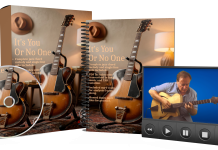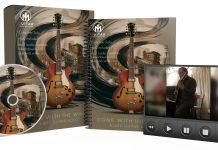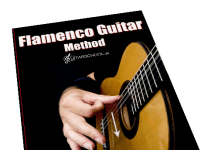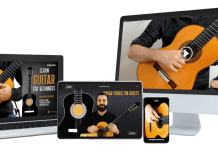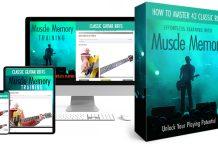This post may contain affiliate links. As an Amazon associate, Google associate as well as associate for other programs, Guitar & Music Institute may earn commissions from qualifying purchases.
HOW TO PRACTICE GUITAR – MAXIMISE THE BENEFIT OF YOUR TIME
I suppose the meaning behind the question when students ask “how to practice guitar” is; “I’m not developing as fast as I’d like”. This is the real question. Or, the other phrase is “I seem to be hitting a brick wall”.
Frustration is usually behind these questions about practice. Or if I’m asked the best way on how to practice guitar scales they are really saying “I can’t play my scales fast enough”.
WHAT IS A GOOD GUITAR PRACTICE ROUTINE
The first thing to establish is that one guitar practice schedule will not fit everyone. We’re all different so we need to embrace that. What you do need to understand is that there are basically two types of guitar practice.
- Taking in new ideas & guitar techniques – This is where you sit down and consider what you want to learn. You actually study and work on concepts such as arpeggios, scales, chords, guitar techniques or whatever. You need to do this type of study, but you also need to understand that for most people, this can only last for forty minutes. After that, you will find yourself staring at the wall thinking about what your having for tea etc.
- Working on existing technique – This is the type of practice that most people do. They sit endlessly shredding away at the things they already know. If you recognise yourself in the last sentence and you are unhappy with how you are practicing, then read on. This article is for you!
Do you have an actual map for your destination?
This is one of the biggest problems. People don’t actually know what they are trying to achieve. They just sit down and bash away at the guitar. Don’t get me wrong, this is good in itself, however, it does not match up with one of the points made above. It also means that you don’t know if you are actually making any progress. Why? Well the reason is you have no way of actually measuring your progress. Morale is a huge part of playing any instrument. Before I go on to talk about morale, I’d like to talk about environment which has a big part in how to practice guitar.
HOW TO PRACTICE GUITAR – WHERE DO YOU PRACTICE?
If you sit on the side of the bed when you are practicing your arpeggios or scales, is this really the best thing for concentrated work? You need an area that is sometimes referred to as a “creative space”. Now, not everyone has a large area to work with, however, you don’t need much space to have an area that you can be creative in.

MY OWN CREATIVE AREA
You can see my creative space in the image here. It is in an almost horse shoe shape. When I am in this area, I’m working. Okay, I love my work, but it is my work area. This is important. Psychologically I know I am there to actually achieve something within the area that I earn my living. Now, I don’t sit there and say this to myself, but this is the fact that is engrained in my brain and helps keep me focussed. The main point about creative spaces is that they give you the majority of what you need to do your work in the area where you work. Your music books are close to hand. Computers used for composition or work related ideas are all close to hand. Instruments, music stand, a good upright chair, near natural light. All of these things are meaningful for creating an area that you feel good in. That helps you maintain a good posture to avoid back ache in the short or long term.
TO CONCLUDE THIS SECTION
So to conclude this section. Make sure that you have an area where you always go to to play and practice your guitar. Make sure you have a good chair, it’s near natural light (a window) and that everything you need is near you.
A PRACTICE ROAD MAP
I am not going to give you a road map example here. You are going to make up your own example. I am going to talk about the things that you will need within your road map.
In creating a roadmap or a journey if you like, you will be creating the conditions whereby you actually have the means to create a way of measuring your actual progress. This gets to the heart of the matter. If you have a way of gauging whether you are making progress, then you will either be able to continue your progress if you’re doing things right, or change them if you are not. It means that by rectifying the mistakes you are making in your practice time you will help to keep your morale high.
A LONELY PATH GRASSHOPPER
Playing an instrument is by it’s very nature a very personal and lonely pursuit. You do it by and large on your own. It’s only when you come together with others that you then find out if all the work you have done is paying off. It’s important therefore that this time which, let’s face it, is like the part of the iceberg you don’t see is paying off.
WHY THIS MATTERS
The better your preparation, the better you will be able to keep those nerves under control when it matters; gig time!
So how do we start to create a roadmap that will help us to find out if our work is actually paying off with meaningful dividends when it comes to our playing the instrument? Read on.
SOME IDEAS TO CONSIDER
The first thing you should do is to get a blank piece of paper. I want you to think about and write down the following so you begin to consider how to practice guitar:
- Short term goals
- Some medium term goals
- Your long term goals
Short term goals – This could be used to tackle an obvious problem. It could be that you don’t know enough guitar chords. It could be that you don’t know some or many guitar scales. Only you know where your true weaknesses are. Be honest and write down the things you can easily attain within a short space of time. This is NOT the place to put “I want to be the fastest guitarists in the world”!
Medium term goals – These will be areas of knowledge and instrumental playing ability that are harder to define. They are less tangible. It could be something like having better time. Ensuring that you can play over a blues in any key. Or, it could be that you can play over all II – V – I chord progressions on all sets of strings.
Long term goals – Now you can put down where you want to be in the long term. By long term, you would probably not want to think more than two or three years. This could and probably should be different in nature to the first two goals. It could be that you want to be able to improvise over hard chromatic chord progressions. It could be something that is connected with playing but not practice specific; that you are playing in a band etc.
HONESTY IS THE BEST POLICY
If you have done the above then sit back and look at it. You will know if you have been honest or not. You absolutely need to face up to the areas that you know you are underachieving in or need extra attention. Only when you can do this, will you have your roadmap that is working for you. Now you are ready to answer the question on how to practice guitar.
FILLING OUT YOUR PRACTICE SESSION ROUTINE
Work out from the areas above the specific areas that need work on. This could be the usual, but it’s your roadmap so it could be anything that you feel is important. An common example would be; scales, arpeggios, chords, learn new songs, sight reading, work on improvisation. The list is not endless, but it could be a long list.
Then, write out subsections to the above. These will be more detailed. You will fill in the actual content that you will be working on. This is the nuts and bolts of what you really need to learn for example “the C major scale” or whatever. Always keep in mind that you need to address the three goal areas outlined earlier. It is important that you don’t confuse them.
LAY OUT A WEEKLY AND MONTHLY PLANNER
Now that you have specifics, create a weekly practice schedule for the content you need to practice and learn. This should be an easy task if you have a computer, if not, then you’re back to ruler and pencil. Fill in your daily workflow with what you want to achieve.
HOW LONG SHOULD YOU PRACTICE FOR
This is one of the biggest questions asked when discussing how to practice guitar. Now, I heard many years ago and I don’t know if it’s true that the great classical guitarist Andres Segovia once said “anyone that practices for eight hours a day is either mad or a liar”. It’s an interesting quote, but as I said, I don’t know if it’s true. Eight hours a day seems to be the mark of someone who is truly committed. Of course, today there are well known guitarists who say they practise ten hours a day…they really know where it’s at…
Anyway, you should not feel bad if you can’t practice for EIGHT HOURS A DAY. You should feel bad if you don’t get the most out of the hours you actually have to spend on your practice routine.
Remember, you need to balance out points one and two from the beginning of this article. A balance between learning new material and practicing the old licks and ideas you can already play well.
WHAT HAPPENS NEXT?
Get yourself a practice diary, just a small notepad you can keep in your pocket. This is not to show a teacher. It’s not going to be that detailed as your only going to be writing short notes in it. The diary is there so that every time you finish a practice session you write down the date, time you spent practicing and if possible in one word per subject what you did.
This diary is not meant to be something to hit yourself over the head with. It’s there so that at the end of each month you can have a glance and see what “exactly you have been practicing”. This will guide you in what your future practice sessions contain.
THAT ABOUT WRAPS IT UP
Okay, well I hope I have given you food for thought on how to practice guitar and your a little clearer on the subject. Keep in mind that life is like a three legged stool; work, rest and play. Make sure that if you action any of the material from this article, that you balance out your life. That you have something to say when you play guitar, not just a bunch of scales.
If you are an eight hours a day guy then have the occasion break. Go for a walk in the park, or hills. Take a tea or coffee break from time to time. Phone a friend!
I’d love to hear your thoughts on your practice and how you made it better. Join GMI and leave your comments below. To your practice and playing.
This post may contain affiliate links. As an Amazon associate, Google associate as well as associate for other programs, Guitar & Music Institute may earn commissions from qualifying purchases.



